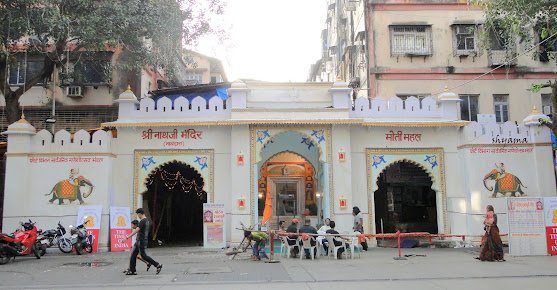Shrinathji is the 7-year form of Lord Krishna. Shrinathji is a form of the Hindu god Krishna, appearing in the form of a seven-year-old boy. The main Shrinathji temple is located in the temple city of Nathdwara, 49 km northeast of the city of Udaipur, Rajasthan. Shrinathji is the central presiding deity of the Vaishnava sect known as Pushtimarg (the way of grace) or the Vallabh sect founded by Vallabhacharya. Shrinathji is mainly worshiped by the followers of Bhakti Yoga and Vaishnavas in Gujarat and Rajasthan and Bhatia and others.
Vallabhacharya’s son, Vitthalnathji, institutionalized Shrinathji worship at Nathdwara. Due to the popularity of Shrinathji, the city of Nathdwara is known as ‘Shrinathji’. People also call it the city of Bawa (Shrinathji Bawa). Initially, the infantile form of Krishna was known as Devadaman (the conqueror of the gods, the superpower of Indra in the raising of the Govardhan hill by Krishna). Vallabhacharya named him Gopal and named his place of worship ‘Gopalpur’. Later, Vitthalnathji called him Shrinathji. The Shrinathji service is performed in 8 parts of the day.
History
Followers of Pushtimarg claim that the hand and face of the form first emerged from Govardhan Hill and then local residents (Vrajavasis) under the spiritual leadership of Madhavendra Puri began to worship the deity Gopal (Krishna). This Gopal deity was later called Shrinathji. Hence, Madhavendra Puri is recognized for discovering Gopal Devta near Govardhan, who was later adapted and worshiped as Shrinathji by Vallabhacharya. Initially, Madhavendra Puri worshiped the deity with raised hands and later, face.
According to Pushtimarg literature, Shrinathji appeared to Shri Vallabhacharya at the Hindu Vikram Samvat of 1549 and instructed Vallabhacharya to begin worship on Mount Govardhan. Vallabhacharya arranged for the worship of that deity, and this tradition was carried on by his son Vitthalnathji.
Shrinathji was brought to the Mewar region of Rajasthan via Agra and Gwalior to guard against the widespread destruction of Hindu temples during the oppressive reign of Aurangzeb. It is believed that the cart carrying the idol got stuck in the mud in the Sihar village of Mewar while traveling, and therefore the idol was installed in a temple with the permission of the then Rana of Mewar. According to religious myths, the Nathdwara Temple was built in the 17th century on a site marked by Shrinathji himself. The temple is also popularly called Shrinathji ki Haveli (Shrinathji’s house) because, like a normal house, it has the movement of a chariot (actually the original chariot in which Shrinathji was brought to Singhar), a place for milk. (Dushghar), a betel nut store (panghar), a sugar and sweet store (mishrighar and padghar), a flower store (phulghar), a functional kitchen (rasighar), a jewelry room (jewelry), a treasure (Kharcha Bhandar), a stable for chariot horses (Ashwashala), a hall (baithak), a gold and silver wheel (chakki). There are many important temples around the world where Shrinathji is worshiped. The “Nathdwara” of the Western Hemisphere is known as Vraj. It is located in Schuylkill Haven, Pennsylvania. More than 100,000 Hindus visit Vraj in a year. Temple priests and servants receive prasad instead of salary as a reward for their duties. Often this prasad is given or sold to guests who come to the temple for darshan.
Followers of Shrinathji have a significant influence on Hindu arts, in the form of Pichwai paintings developed by him. These pictures can be in the form of cloth, paper, wall hangings or temples. These are fine and colorful devotional garments centered on the image of Shrinathji. Nathdwara Pichwai Kala is the center of Nathdwara painting. Nathdwara is known for the Rajasthani style of the city, called “Pichwai painting”. These Pichwai paintings are painted on the wall around the Nathdwara temple by renowned contemporary Nathdwara artists.


0 Comments